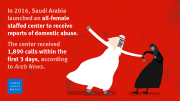In 2012, a Saudi artist who goes by the name Ms Saffaa moved to Sydney to pursue a PhD with a Saudi government scholarship. It was a free ride and Saudi baathat are typically generous. But there was a catch: she needed to live with a “male guardian” who would supervise her during the course of her stay.
“The government asked me a few times to prove that my male guardian was with me. At the time I was, I think, 31 or 32, and I found it humiliating, dehumanizing in many ways,” said Ms Saffaa in an interview with PBS.
It was the “moment that kind of shaped” her career. She decided to create art that centered on male guardianship laws in Saudi Arabia. Her message: “I am my own guardian.”

“We need to acknowledge the bravery of these women, tweeting from inside Saudi Arabia — risking getting arrested and risking their livelihood and safety in order to get their voices heard,” Saffaa added.
Saffaa’s work has reached the masses. Human Rights Watch Executive Director Sarah Leah Whitson even dressed up in Saffaa’s #IAmMyOwnGuardian t-shirt in solidarity with Saudi women.
Oct, 16 marked the 100th day since the hashtag was created.
Women in Saudi Arabia are discriminated against in nearly all aspects of public and private life, mainly due to a legal code influenced by a fundamentalist interpretation of Sharia law.
But in the past year alone Saudi Arabia has amended a number of laws in an effort to empower women in the kingdom, including opening municipal elections to female candidates and making women’s verbal consent to marriage mandatory.
The Saudi Shura Council also announced an amendment to laws governing travel documents, giving women a right to obtain a passport without male permission. This all puts a dent in the kingdom’s guardianship system, which prohibits women from traveling, marrying and working without the permission of a male guardian, typically the husband, father or brother.
Source: stepfeed.com



Be the first to comment at "#IAmMyOwnGuardian: Saudi female artist protests male guardianship laws"